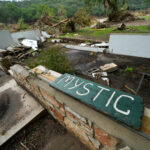America’s top coal mine regulator says he will redouble pressure on the industry to meet a 4-year-old congressional mandate to equip the nation’s underground mines with high-tech communications and tracking gear.
Mine Safety and Health Administration figures show 34 mines nationwide have functioning systems that meet its requirements. The agency says 491 mines are supposed to have the equipment.
The mandate was imposed after the January 2006 deaths of 12 West Virginia miners who became trapped underground following a methane explosion.
Mining companies were given until June 2009 to submit their plans to MSHA on how they intended to have two-way communications systems and wireless equipment to talk with and locate trapped miners. MSHA initially estimated complying would cost $278 million.
MSHA data shows the agency has approved plans for 412 mines and 79 are pending.
Now, a disappointed MSHA Director Joe Main says it’s time to start pressuring mine operators and manufacturers to speed up installation.
Main compared the approach to pressure tactics used to speed up the delivery and storage of extra oxygen supplies required by the same 2006 legislation.
“We’ll leverage out whatever we can,” Main said, noting that MSHA took six mine operators to court two weeks ago. MSHA’s also cited 64 operations for not submitting plans on time — mostly mines located in Kentucky and Tennessee.
National Mining Association lobbyist Bruce Watzman says no one’s happy with the slow progress, but he bristles at suggestions of foot-dragging by the industry.
“The fact of the matter is that this has proceeded more slowly for a whole host of reasons,” Watzman said. “If there is fault, the fault is that I don’t think anyone got very clear guidance from the previous leadership of MSHA.”
Meanwhile, the West Virginia Office of Miners’ Health, Safety and Training disputes the inference from MSHA’s numbers that the state’s mines are behind.
The state also mandated wireless communications and tracking equipment following the Sago explosion and other fatal mining accidents in early 2006. The state requirement was passed before its federal counterpart.
“There is no place in the world that has more communications and tracking,” said Randy Harris, an engineering consultant overseeing West Virginia installations. The industry has spent between $125,000 to $150,000 to wire each of the state’s 197 underground mines.
“We’ve had several instances already where there’s been problems and the communications and tracking system has worked and gotten everybody out,” Harris said, noting new gear helped with evacuations during 2009 flooding in southern West Virginia.
MSHA’s figures, however, don’t reflect West Virginia’s progress.
Instead, the figures show 20 mines in southern West Virginia and just three in the MSHA district covering northern West Virginia have systems up and running that meet federal requirements.
Harris says MSHA requires more equipment such as readers for tracking tags on miners that are closer together. MSHA also insists that mines have the gear within 200 feet of the working face, or where the coal is being mined. West Virginia does not require gear at the face.
Data collected by MSHA’s 11 districts nationwide show 46 mines have tracking and communications equipment installed and working, though just 34 meet all its requirements. Another 92 mines have partial systems running and 128 are working on installations.
“I think progress is being made everywhere, but the majority of West Virginia, they had kind of a head start,” said Kevin Stricklin, MSHA administrator for Coal Mine Safety and Health.
Overall, Stricklin describes efforts to upgrade safety equipment as piecemeal.
“We have mines, as an example, in western Kentucky that have up to 90 percent of their systems installed.”
Main shrugs off industry complaints about MSHA waiting until December 2008 to release plans for how companies were to comply with the mandate.
What’s being installed underground are systems built around handheld radios that work through networks designed to survive explosions. Each miner wears a locator tag so he can be found quickly in the event of an accident.
At West Virginia’s Sago Mine, communications were severed by the explosion and rescue teams were left to guess where miners were located.
“There’s no question we’re better off than we were the day before Sago,” Main said.
Was this article valuable?
Here are more articles you may enjoy.

 World’s Top 10 Extreme Weather Events in 2025
World’s Top 10 Extreme Weather Events in 2025  Severity Was up, But How Will Falling Claims Volume Impact The Profession?
Severity Was up, But How Will Falling Claims Volume Impact The Profession?  Grok Sexual Images Draw Rebuke, France Flags Content as Illegal
Grok Sexual Images Draw Rebuke, France Flags Content as Illegal  Target, Walmart, Whole Foods Targeted in Botulism Suits
Target, Walmart, Whole Foods Targeted in Botulism Suits 